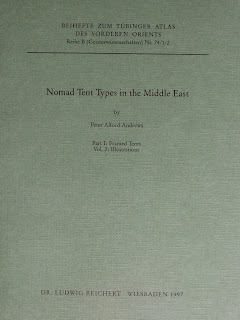The nature of tents is that they are sufficiently light so they can be transported by whatever means are available. That used to be pack animals, but now among the remaining nomads it could be a truck as well. But the light weight of a tent makes it vulnerable to wind. If the tent is not sufficiently staked down, it may well be blown away. In the case of my twelve foot yurt, I put stakes into the ground around the perimeter of the yurt and tied lines to them that ran up to the edge of the roof.
In the case of the Iranian nomads in Andrews' book they drive a stake into the ground in the center of their tent and run lines from the perimeter of the crown down to the stake. While this arrangement helps to keep the tent anchored in a storm, it also has structural functions.
 |
| Perspective drawing of Iranian yurt. The stake to which the crown is anchored is visible just above the center of the door. |
 |
| Photo of the anchor rope running from the crown down to the center stake. The stake is driven into the ground to a depth of about 3 feet. |
 |
| Details of stake, mallet and alternative method of anchoring the crown. |
This scheme of anchoring a yurt would probably not work as well for a yurt with trellis walls because the trellis sits on the ground and unlike the poles of this Iranian tent are not pushed into the ground which is what keeps them from shifting sideways. In any case, the central anchor is probably something to consider for the would-be yurt builder.
By the way, these illustrations show the degree of detail Andrews' book contains. For this particular tent, Andrews has several more pages of detail on everything from crown construction, to cover tailoring to tools used in the construction of the frame.









